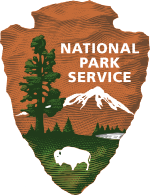Chrysler Building
| Chrysler Building | |
|---|---|
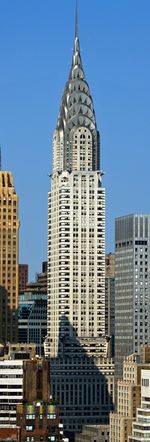 |
|
|
Chrysler Building was the world's tallest building from 27 May 1930 to 1931.[I] |
|
| Record height | |
| Preceded by | 40 Wall Street |
| Surpassed by | Empire State Building |
| General information | |
| Location | 405 Lexington Avenue, Manhattan, NY, United States |
| Status | Complete |
| Constructed | 1928-1930 |
| Use | Office |
| Height | |
| Antenna or spire | 318.9 m (1,046 ft) |
| Roof | 282.0 m (925 ft) |
| Top floor | 274.0 m (899 ft) |
| Technical details | |
| Floor count | 77 [1] |
| Floor area | 1,195,000 sq ft (111,000 m2) |
| Elevators | 32 |
| Companies involved | |
| Architect(s) | William Van Alen |
| Owner |
|
|
^ Fully habitable, self-supported, from main entrance to highest structural or architectural top; see the list of tallest buildings in the world for other listings. |
|
| Chrysler Building | |
|---|---|
| U.S. National Register of Historic Places | |
| U.S. National Historic Landmark | |
 Location in New York City
|
|
| Coordinates: | |
| Architectural style(s): | Art Deco |
| Governing body: | Local |
| Added to NRHP: | 1976[2] |
| Designated NHL: | December 8, 1976[3] |
| NRHP Reference#: | 75001237 |
The Chrysler Building is an Art Deco skyscraper in New York City, located on the east side of Manhattan in the Turtle Bay area at the intersection of 42nd Street and Lexington Avenue. Standing at 319 metres (1,047 ft),[4][5] it was the world's tallest building for 11 months before it was surpassed by the Empire State Building in 1931. After the destruction of the World Trade Center, it was again the second-tallest building in New York City until December 2007, when the spire was raised on the 365.8-metre (1,200 ft) Bank of America Tower, pushing the Chrysler Building into third position. In addition, The New York Times Building which opened in 2007, is exactly level with the Chrysler Building in height.[6]
The Chrysler Building is a classic example of Art Deco architecture and considered by many contemporary architects to be one of the finest buildings in New York City. In 2007, it was ranked ninth on the List of America's Favorite Architecture by the American Institute of Architects.[7] It was the headquarters of the Chrysler Corporation from 1930 until the mid 1950's, but although the building was built and designed specifically for the car manufacturer, the corporation didn't pay for the construction of it and never owned it, as Walter P. Chrysler decided to pay for it himself, in order for his children to inherit it.[8]
Contents |
History
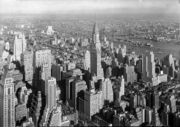
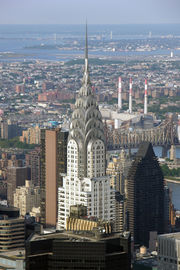

The Chrysler Building was designed by architect William Van Alen for a project of Walter P. Chrysler.[8] When the ground breaking occurred on September 19, 1928, there was an intense competition in New York City to build the world's tallest skyscraper.[9][10] Despite a frantic pace (the building was built at an average rate of four floors per week), no workers died during the construction of this skyscraper.[11]
Design beginnings
Van Alen's original design for the skyscraper called for a decorative jewel-like glass crown. It also featured a base in which the showroom windows were tripled in height and topped by twelve stories with glass-wrapped corners, creating an impression that the tower appeared physically and visually light as if floating on mid-air.[8] The height of the skyscraper was also originally designed to be 246 metres (807 ft).[11] However, the design proved to be too advanced and costly for building contractor William H. Reynolds, who disapproved of Van Alen's original plan.[12] The design and lease were then sold to Walter P. Chrysler, who worked with Van Alen and redesigned the skyscraper for additional stories; it was eventually revised to be 282 metres (925 ft) tall.[11] As Walter Chrysler was the chairman of the Chrysler Corporation and intended to make the building into Chrysler's headquarters,[11] various architectural details and especially the building's gargoyles were modeled after Chrysler automobile products like the hood ornaments of the Plymouth; they exemplify the machine age in the 1920s (see below).[13][14]
Construction
Construction commenced on September 19, 1928.[11] In total, almost 400,000 rivets were used[11] and approximately 3,826,000 bricks were manually laid, to create the non-loadbearing walls of the skyscraper.[15] Contractors, builders and engineers were joined by other building-services experts to coordinate construction.
Prior to its completion, the building stood about even with a rival project at 40 Wall Street, designed by H. Craig Severance. Severance increased the height of his project and then publicly claimed the title of the world's tallest building[16] (this distinction excluded structures that were not fully habitable, such as the Eiffel Tower[17]). In response, Van Alen obtained permission for a 56.3-metre (185 ft) long spire[18] and had it secretly constructed inside the frame of the building. The spire was delivered to the site in 4 different sections.[19] On October 23, 1929, the bottom section of the spire was hoisted onto the top of the building's dome and lowered into the 66th floor of the building. The other remaining sections of the spire were hoisted and riveted to the first one in sequential order in just 90 minutes.[20]
Completion
Upon completion, May 28, 1930,[11] the added height of the spire allowed the Chrysler Building to surpass 40 Wall Street as the tallest building in the world and the Eiffel Tower as the tallest structure. It was the first man-made structure to stand taller than 1,000 feet (305 m). Van Alen's satisfaction in these accomplishments was likely muted by Walter Chrysler's later refusal to pay the balance of his architectural fee.[8] Less than a year after it opened to the public on May 27, 1931, the Chrysler Building was surpassed in height by the Empire State Building, but the Chrysler Building is still the world's tallest steel-supported brick building.[21][22] (The world's tallest brick building without steel is St. Martin's Church in Landshut begun in 1389.)
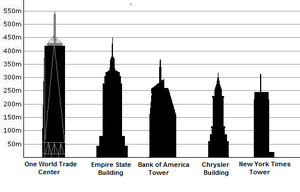
Property
The east building wall of the base out of which the tower rises runs at a slant to the Manhattan street grid, following a property line that predated the Commissioners' Plan of 1811.[23] The land on which the Chrysler Building stands was donated to The Cooper Union for the Advancement of Science and Art,[24] a private college that offers every admitted student a full tuition scholarship, in 1902. The land was originally leased to William H. Reynolds, but when he was unable to raise money for the project, the building and the rights to the land were acquired by Walter P. Chrysler in 1928.[24] The land continues to be owned by the college.[25] Contrary to popular belief, the Chrysler Corporation was never involved in the construction or ownership of the Chrysler Building, although it was built and designed for the corporation and served as its headquarters until the mid 1950s. It was a project of Walter P. Chrysler for his children.[8]
The ownership of the building has changed several times. The Chrysler family sold the building in 1947, and in 1957 it was purchased by real-estate moguls Sol Goldman and Alex DiLorenzo, and owned by Massachusetts Mutual Life Insurance Company. The lobby was refurbished and the facade renovated in 1978–1979.[26] The building was owned by Jack Kent Cooke, a Washington, D.C. investor, in 1979. The spire underwent a restoration that was completed in 1995. In 1998, Tishman Speyer Properties and the Travelers Insurance Group bought the Chrysler Building, at 42nd Street and Lexington Avenue, and the adjoining Kent Building in 1997 for about $220 million from a consortium of banks and the estate of Jack Kent Cooke. Tishman Speyer Properties had negotiated a 150 year lease on the land from Cooper Union, which had held the lease before 1997, and continues to hold the land lease.[27]
In 2001, a 75% stake in the building was sold, for US$ 300 million, to TMW, the German arm of an Atlanta-based investment fund.[28] On June 11, 2008 it was reported that the Abu Dhabi Investment Council was in negotiations to buy TMW's 75% economic interest, and a 15% interest from Tishman Speyer Properties in the building, and a share of the Trylons retail structure next door for US$ 800 million.[29] On July 9, 2008 it was announced that the transaction had been completed, and that the Abu Dhabi Investment Council was now the 90% owner of the building.[27][30]
Architecture
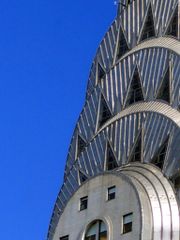
The Chrysler Building is considered a masterpiece of Art Deco architecture. The distinctive ornamentation of the building based on features that were then being used on Chrysler automobiles. The corners of the 61st floor are graced with eagles, replicas of the 1929 Chrysler hood ornaments;[31] on the 31st floor, the corner ornamentation are replicas of the 1929 Chrysler radiator caps.[32] The building is constructed of masonry, with a steel frame, and metal cladding. In total, the building currently contains 3,862 windows on its facade and 4 banks of 8 elevators designed by the Otis Elevator Corporation.[11] The building was declared a National Historic Landmark in 1976.[3][33]
Crown ornamentation
The Chrysler Building is also well renowned and recognized for its terraced crown. Composed of seven radiating terraced arches, Van Alen's design of the crown is a cruciform groin vault constructed into seven concentric members with transitioning setbacks, mounted up one behind each other.[34] The stainless-steel cladding is ribbed and riveted in a radiating sunburst pattern with many triangular vaulted windows, transitioning into smaller segments of the seven narrow setbacks of the facade of the terraced crown. The entire crown is clad with silvery "Enduro KA-2" metal, an austenitic stainless steel developed in Germany by Krupp and marketed under the trade name "Nirosta" (a German acronym for nichtrostender Stahl, meaning "non-rusting steel").[8][35]
Crown usage
When the building first opened, it contained a public viewing gallery on the 71st floor, which was closed to the public in 1945. This floor is now the highest-occupied floor, most recently occupied by an office space management firm.[36] The private Cloud Club occupied a three-floor high space from the 66th–68th floors, but closed in the late 1970s. Above the 71st floor, the stories of the building are designed mostly for exterior appearance, functioning mainly as landings for the stairway to the spire. Very narrow with low, sloped ceilings, these top stories are useful only for holding radio-broadcasting and other mechanical and electrical equipment.[11] Television station WCBS-TV (Channel 2) originally transmitted from the top of the Chrysler in the 1940s and early 1950s, before moving to the Empire State Building.[11] For many years, WPAT-FM and WTFM (now WKTU) also used the Chrysler Building as a transmission site, but they also moved to the Empire by the 1970s. There are currently no commercial broadcast stations located at the Chrysler Building.
Lighting
There are two sets of lighting in the top spires and decoration. The first are the V-shaped lighting inserts in the steel of the building itself. Added later were groups of floodlights which are on mast arms directed back at the building. This allows the top of the building to be lit in many colors for special occasions. This lighting was installed by electrician Charles Londner and crew during construction.[11]
Recognition and appeal
In more recent years, the Chrysler Building has continued to be a favorite among New Yorkers. In the summer of 2005, New York's own Skyscraper Museum asked one hundred architects, builders, critics, engineers, historians, and scholars, among others, to choose their 10 favorites among 25 New York towers. The Chrysler Building came in first place as 90% of them placed the building in their top-10 favorite buildings.[37]
The Chrysler Building's distinctive profile has inspired similar skyscrapers worldwide, including One Liberty Place in Philadelphia.[38][39]
Cultural depictions
The Chrysler Building has been featured in several television programs, movies, and other media. Below are examples.
In an early episode of Saturday Night Live the Coneheads launch the building as a rocketship to return to their home planet. In the 1982 Larry Cohen film Q a winged serpent terrorizing New York is nesting inside the building's crown; the film's poster depicts the monster perched atop the building holding an attractive blonde victim in its claws.[40] (The poster's monster is enormously out of scale to its size in the movie.) The Chrysler Building was also a short scene in the movie Predator 2 where the predator is holding a trophy raising it up on the building. The artwork was done by Michael Whelan.[41] In Deep Impact (1998) a wall of water surrounds the skyscraper and people can be seen on the 61st-floor observation deck fleeing to the other side of the building.[42] The tower was also prominently featured and being destroyed in the 1998 film, Godzilla[42], and in Armageddon, which featured the tower being struck by a meteor, causing its spire to come crashing to the ground.[42] In another film, Fantastic Four: Rise of the Silver Surfer, while Johnny Storm chases the Silver Surfer through Manhattan, the Silver Surfer flies straight through the Chrysler Building.[43][44] Towards the end of Steven Spielberg's A.I.: Artificial Intelligence, the Chrysler Building is seen totally underwater as the mechas guide their spacecraft through the submerged ruins of Manhattan.[42] In the film Spider-Man, Spider-Man perches on top of one of the building's gargoyles, mourning his Uncle Ben's murder.[42]
In the music scene, Meat Loaf's 1993 album Bat Out of Hell II: Back Into Hell's cover art depicts a demonic bat clinging to the top floors of the Chrysler Building. The Chrysler Building has also appeared in numerous video games such as Grand Theft Auto IV, being replicated as the "Zirconium Building".[45][46]
Quotations
-
- "Art Deco in France found its American equivalent in the design of the New York skyscrapers of the 1920s. The Chrysler Building ... was one of the most accomplished essays in the style."
- –John Julius Norwich, in The World Atlas of Architecture
- "Art Deco in France found its American equivalent in the design of the New York skyscrapers of the 1920s. The Chrysler Building ... was one of the most accomplished essays in the style."
-
- "The design, originally drawn up for building contractor William H. Reynolds, was finally sold to Walter P. Chrysler, who wanted a provocative building which would not merely scrape the sky but positively pierce it. Its 77 floors briefly making it the highest building in the world—at least until the Empire State Building was completed—it became the star of the New York skyline, thanks above all to its crowning peak. In a deliberate strategy of myth generation, Van Alen planned a dramatic moment of revelation: the entire seven-storey pinnacle, complete with special-steel facing, was first assembled inside the building, and then hoisted into position through the roof opening and anchored on top in just one and a half hours. All of a sudden it was there—a sensational fait accompli."
- –Peter Gossel and Gabriele Leuthauser, in Architecture in the Twentieth Century
- "The design, originally drawn up for building contractor William H. Reynolds, was finally sold to Walter P. Chrysler, who wanted a provocative building which would not merely scrape the sky but positively pierce it. Its 77 floors briefly making it the highest building in the world—at least until the Empire State Building was completed—it became the star of the New York skyline, thanks above all to its crowning peak. In a deliberate strategy of myth generation, Van Alen planned a dramatic moment of revelation: the entire seven-storey pinnacle, complete with special-steel facing, was first assembled inside the building, and then hoisted into position through the roof opening and anchored on top in just one and a half hours. All of a sudden it was there—a sensational fait accompli."
-
- "One of the first uses of stainless steel over a large exposed building surface. The decorative treatment of the masonry walls below changes with every set-back and includes story-high basket-weave designs, radiator-cap gargoyles, and a band of abstract automobiles. The lobby is a modernistic composition of African marble and chrome steel."
- –Elliot Willensky and Norval White, in AIA Guide to New York
- "One of the first uses of stainless steel over a large exposed building surface. The decorative treatment of the masonry walls below changes with every set-back and includes story-high basket-weave designs, radiator-cap gargoyles, and a band of abstract automobiles. The lobby is a modernistic composition of African marble and chrome steel."
Gallery
 One of the Eagles on the 61st Floor |
 Chrysler Building next to the Calyon Building |
 View from one of the north-facing triangular windows |
 Elevator interior with inlaid wood |
|
Illumination of the building at night |
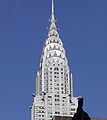 The building's distinctive crown |
The building rising into the sky |
 A view of the Chrysler Building from the Empire State Building |
See also
- Buildings and architecture of New York City
- 50 Tallest buildings in the U.S.
- Tallest buildings in New York City
- World's tallest structures
- List of tallest buildings and structures in the world
- List of tallest freestanding structures in the world
- List of buildings
References
- Skyscrapers, Antonino Terranova, White Star Publishers, 2003 (ISBN-8880952307)
- The Chrysler Building: Creating a New York Icon Day by Day, D Stravitz, Princeton Architectural Press Publishers, 2002 (ISBN 1568983549)
Notes
- ↑ Nash, Eric Peter; McGrath, Norman (1999). Manhattan Skyscrapers. Princeton Architectural Press. p. 63. ISBN 9781568981819. http://books.google.com/?id=l3aAA2Di1YkC&pg=PA63&dq=Chrysler+building+number+of+stories&q=.
- ↑ "National Register Information System". National Register of Historic Places. National Park Service. 2007-01-23. http://www.nr.nps.gov/.
- ↑ 3.0 3.1 "Chrysler Building". National Historic Landmark summary listing. National Park Service. http://tps.cr.nps.gov/nhl/detail.cfm?ResourceId=1638&ResourceType=Building.
- ↑ "Map." Turtle Bay Association. Retrieved on January 25, 2009.
- ↑ The Chrysler Building – SkyscraperPage.com
- ↑ Emporis Data – See Tallest buildings Ranking
- ↑ FavoriteArchitecture.org
- ↑ 8.0 8.1 8.2 8.3 8.4 8.5 "How two men's dreams changed the skyline of New York". http://www.jayebee.com/discoveries/criticism/silver_spire.htm. - Article in The New Yorker November 18, 2002
- ↑ Emporis Data "...a celebrated three-way race to become the tallest building in the world."
- ↑ The Manhattan Company – Skyscraper.org; "...'race' to erect the tallest tower in the world."
- ↑ 11.00 11.01 11.02 11.03 11.04 11.05 11.06 11.07 11.08 11.09 11.10 University of Wisconsin–Madison; School of Engineering – The Chrysler Building
- ↑ Emporis.com – Chrysler Building
- ↑ "Chrysler Building". glasssteelandstone.com. http://glasssteelandstone.com/BuildingDetail.php?ID=436. Retrieved 2008-10-11.
- ↑ Emporis Data
- ↑ The Chrysler Building, Creating a New York icon, day by day. Pages 54, 158, image caption no.39 ISBN 1-56898-354-9
- ↑ Emporis Data – See source no.4 line 4; "Briefly held the world's tallest title until it was eclipsed by the spire of Chrysler Building."
- ↑ CTBUH – Criteria of World's Tallest Building
- ↑ The Chrysler Building, Creating a New York icon, day by day. Page 161. Image caption no.39 – ISBN 1-56898-354-9
- ↑ The Chrysler Building, Creating a New York icon, day by day. Page 161, image caption no.54 ISBN 1-56898-354-9
- ↑ The Chrysler Building, Creating a New York icon, day by day. Pages xiii (Paragraph 10) and 161. Image caption no.39 – ISBN 1-56898-354-9
- ↑ The World's Tallest Brick Building – SkyscraperPicture.com
- ↑ A view from Above – The Chrysler Building
- ↑ Noted in Kevin Walsh, Forgotten New York: The Ultimate Urban Explorer's Guide to All Five Boroughs, 2006:171.
- ↑ 24.0 24.1 Cooper Union and Chrysler Building
- ↑ The New York Times – Cooper Union
- ↑ "An enduring hood ornament". http://www.signonsandiego.com/uniontrib/20050619/news_mz1h19chrysl.html.
- ↑ 27.0 27.1 Bagli, Charles V. (July 10, 2008). "Abu Dhabi Buys 90% Stake in Chrysler Building". New York Times. http://www.nytimes.com/2008/07/10/nyregion/10chrysler.html. Retrieved June 8, 2009.
- ↑ Bagli, Charles V. (March 5, 2001). "German Group Buys Stake In Skyscraper". The New York Times. http://query.nytimes.com/gst/fullpage.html?res=9B06E7DB133BF936A35750C0A9679C8B63. Retrieved April 30, 2010.
- ↑ "CHRYSLER BUILDING ON THE BLOCK - SOVEREIGN ARAB FUND TO PAY $800M". http://www.nypost.com/seven/06112008/business/chrysler_bldg__on_the_block_115016.html.
- ↑ "New York's Chrysler Building Bought by Abu Dhabi Fund". http://www.bloomberg.com/apps/news?pid=20601087&sid=aACZuFPo8cf8&refer=home.
- ↑ Unaccredited image
- ↑ 1926 Chrysler Radiator Cap Used On The Chrysler Building
- ↑ Carolyn Pitts (August, 1976) (PDF). National Register of Historic Places Inventory-Nomination: Chrysler Building. National Park Service. http://pdfhost.focus.nps.gov/docs/NHLS/Text/76001237.pdf. Retrieved 2009-05-03 and Accompanying 1 photo, exterior, undatedPDF (164 KB)
- ↑ The City Review.com – Chrysler Building by AIA Carter B. Horsley
- ↑ Article: Trade names associated with stainless steels
- ↑ MrBellersNeighborhood - Inside the Needle: The Chrysler Building Gets Lit by David Michaelis
- ↑ "In a City of Skyscrapers, Which Is the Mightiest of the High? Experts Say It's No Contest", The New York Times, September 1, 2005. Accessed April 8, 2008.
- ↑ The NY Times ARCHITECTURE VIEW; Giving New Life to Philadelphia's Skyline. Paragraph 6, line 4, Quote: "...The tower resembles nothing so much as the Chrysler Building..."
- ↑ University of Wisconsin–Madison; School of Engineering – One Liverty Place; Slide 18, Building Materials
- ↑ http://en.wikipedia.org/wiki/File:Qfilmposter.jpg
- ↑ A demonic bat on the top of the Chrysler Building
- ↑ 42.0 42.1 42.2 42.3 42.4 The NY Times – In the Background, but No Bit Player
- ↑ Yahoo! Movies: Fantastic Four: Rise of the Silver Surfer (2007)
- ↑ Movielocationguide – Rise of the Silver Surfer filming location
- ↑ Paragraph 3, Hilary Goldstein, Chief News and Features Editor, IGN.com quoted: "...with numerous identifiable landmarks, including the Chrysler Building..."
- ↑ Grand Theft Auto IV – Liberty City real World comparisons
External links
- The story of Chrysler Building – by CBS Forum
- Salon.com article (02/2002)
- New York Architecture Images-the Chrysler Building
- Chrysler Building: Lighthearted & Serious, by Anthony Romeo, AIA
| Records | ||
|---|---|---|
| Preceded by Eiffel Tower |
World's tallest structure 1930–1931 |
Succeeded by Empire State Building |
| Preceded by 40 Wall Street |
Tallest building in the world 1930–1931 |
|
| Tallest building in the United States 1930–1931 |
||
| Tallest building in New York City 1930–1931 |
||
|
||||||||
|
|||||||||||||||||
|
||||||||||||||||||||||||||||||||||||||||||||||||||||||||||||||
